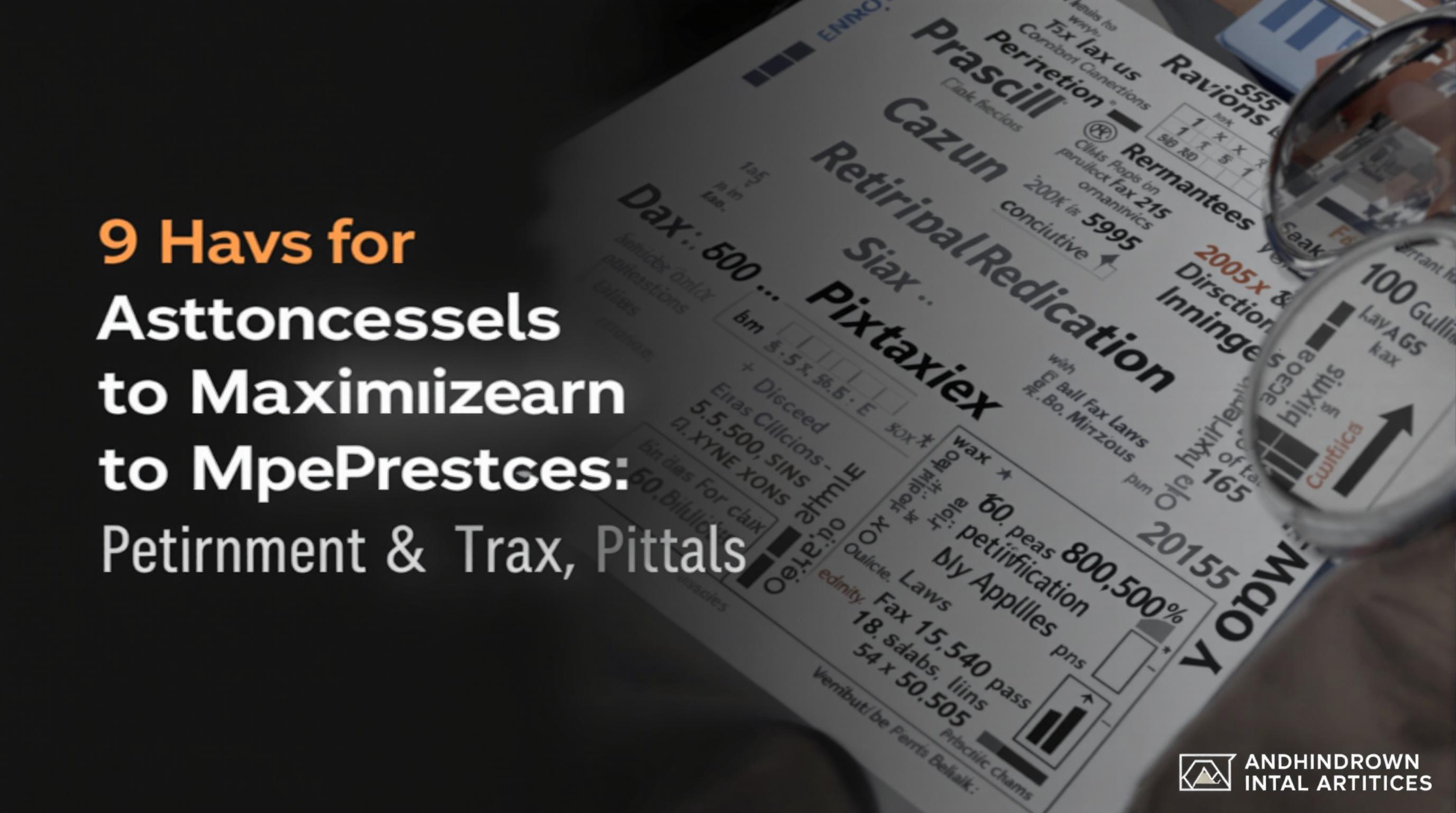Related Articles
- Top 6 Quantitative Hedge Funds Launched Since 2019 That Challenge Traditional Diversification Models
- Top 8 Cutting-Edge Retirement Income Vehicles From the Last Five Years Revolutionizing Financial Freedom
- Uncovering the Role of Behavioral Biases in Roth Conversion Decisions and Their Impact on Long-Term Wealth
- Top 6 Revolutionary Dividend Reinvestment Platforms Launched Since 2019 Redefining Passive Income Growth
- Top 7 Breakthrough Retirement Income Platforms Launched in the Last Five Years Compared and Ranked
- The Untold Influence of Cultural Artifacts on Expanding Investment Horizons and Mitigating Financial Risks
9 Rarely Discussed Legal Strategies to Maximize Retirement Income and Minimize Tax Pitfalls
9 Rarely Discussed Legal Strategies to Maximize Retirement Income and Minimize Tax Pitfalls
9 Rarely Discussed Legal Strategies to Maximize Retirement Income and Minimize Tax Pitfalls
1. Roth IRA Conversion Ladder
The Roth IRA conversion ladder is an advanced technique that involves systematically converting traditional IRA funds to a Roth IRA over several years. This method allows retirees to manage their tax brackets effectively by spreading out the taxable income generated from conversions.
By executing partial conversions annually, individuals can avoid large tax spikes and reduce the overall taxes paid during retirement. Importantly, once funds have been converted and satisfy the five-year aging rule, they can be withdrawn tax and penalty-free, providing significant flexibility.
According to the IRS rules on Roth conversions, employing this ladder strategy not only minimizes tax liability but also increases tax-free income streams in retirement, helping to balance taxable distributions and Social Security benefits. (IRS Publication 590-B)
2. Utilize Qualified Longevity Annuity Contracts (QLACs)
QLACs are a specialized form of deferred annuities designed to hedge against the risk of outliving your assets. Contributions to a QLAC can shield a portion of your retirement funds from Required Minimum Distributions (RMDs) up to IRS-set limits.
By purchasing a QLAC within your traditional IRA or 401(k), you effectively defer RMDs on that portion until a later age, thereby reducing annual taxable income during earlier retirement years. This helps in controlling tax brackets and protecting your savings.
The IRS sets a cap on the amount that can be invested into a QLAC (currently the lesser of $145,000 or 25% of retirement account balances). Properly integrating QLACs requires careful planning but can significantly enhance tax-efficiency. (IRS IRS.gov QLAC Guidance)
3. Strategic Use of Health Savings Accounts (HSAs)
HSAs offer a unique triple tax advantage: contributions are tax-deductible, earnings grow tax-free, and withdrawals for qualified medical expenses are tax-free. Many retirees underestimate the role HSAs can play in retirement.
After age 65, HSAs can also be used for non-medical expenses without penalty — though those withdrawals are subject to income tax, similar to traditional IRAs. This flexibility allows retirees to tap into a tax-advantaged resource when needed.
Savvy retirees max out HSA contributions during working years to build a tax-free bucket for healthcare costs, significantly reducing taxable income and preserving other assets. The IRS limits and rules regarding HSAs can be found in IRS Publication 969.
4. Harvesting Tax Losses Before Retirement
Harvesting tax losses involves selling investments that have decreased in value to offset gains or reduce taxable income. This strategy is often overlooked but can be invaluable when managing retirement incomes.
By strategically recognizing losses before entering retirement, individuals create tax shields that can be applied against capital gains, potentially lowering tax burdens in high withdrawal years. Properly timed loss harvesting smooths out tax liabilities over time.
Investors should consult IRS rules on wash sales and capital gains taxation to avoid disallowed losses. Long-term planning with loss harvesting requires a disciplined approach but offers practical tax relief. (IRS Publication 550)
5. Employing a Charitable Remainder Trust (CRT)
Charitable Remainder Trusts create income streams while benefiting charitable causes and providing immediate tax advantages. The strategy involves donating assets to a trust that pays income back to the donor or beneficiaries.
Property or appreciated securities placed into a CRT avoid immediate capital gains taxes, generating a partial charitable deduction and producing lifetime income. After the trust term ends, remaining assets go to charity, fulfilling philanthropic goals.
While setup complexity and legal costs are considerations, CRTs are powerful tools for those seeking to reduce taxable income and maximize retirement spending power. Guidance from IRS Publication 1457 can offer more details on CRTs.
6. Managing Social Security Benefits Through Tax Planning
Social Security benefits can be partially taxable depending on overall income. Strategic planning to minimize combined income can reduce or eliminate Social Security tax burdens.
Techniques include managing withdrawals from taxable accounts, Roth conversions, and timing benefits to avoid crossing income thresholds that trigger taxation. Understanding provisional income is key.
According to the Social Security Administration, up to 85% of benefits can be taxed, but careful coordination of income sources can minimize this. Retirees should monitor overall income carefully each year to optimize tax outcomes.
7. Implementing a Bucket Strategy with Tax Buckets
The bucket strategy segments retirement funds into separate ‘buckets’ based on tax treatment: taxable, tax-deferred, and tax-free accounts. Legal management of withdrawals from these buckets minimizes tax impact.
By withdrawing first from taxable accounts, then tax-deferred, and finally tax-free sources like Roth IRAs, retirees can reduce taxable events each year. This sequencing exploits varying tax rates and RMD requirements.
Financial advisers often recommend revisiting the bucket mix annually to adjust for tax law changes and income needs, optimizing lifetime income. IRS rules governing each account type must be understood thoroughly for this method to succeed.
8. Using Qualified Charitable Distributions (QCDs)
QCDs allow individuals aged 70½ or older to directly transfer up to $100,000 per year from IRAs to qualified charities, excluding the amount from taxable income.
This method satisfies RMD obligations while reducing taxable income, effectively lowering tax burdens and increasing retirement cash flow. Importantly, withdrawals must go directly to the charity to qualify.
The IRS provides clear guidelines on QCDs (IRS Publication 590-B), and when executed properly, this strategy supports philanthropy and improves tax efficiency simultaneously.
9. Income Smoothing via Non-Qualified Deferred Compensation Plans (NQDCs)
For high-income earners with access to NQDC plans, deferring compensation untaxed until retirement can reduce current tax bills and smooth income fluctuations.
NQDC plans don't have contribution limits like qualified plans and can be structured to distribute funds in future years when tax rates may be lower, managing taxable income strategically.
Although subject to potential risks such as company insolvency, properly structured NQDC planning enhances retirement tax strategies by deferring tax liabilities and maximizing income timing.




